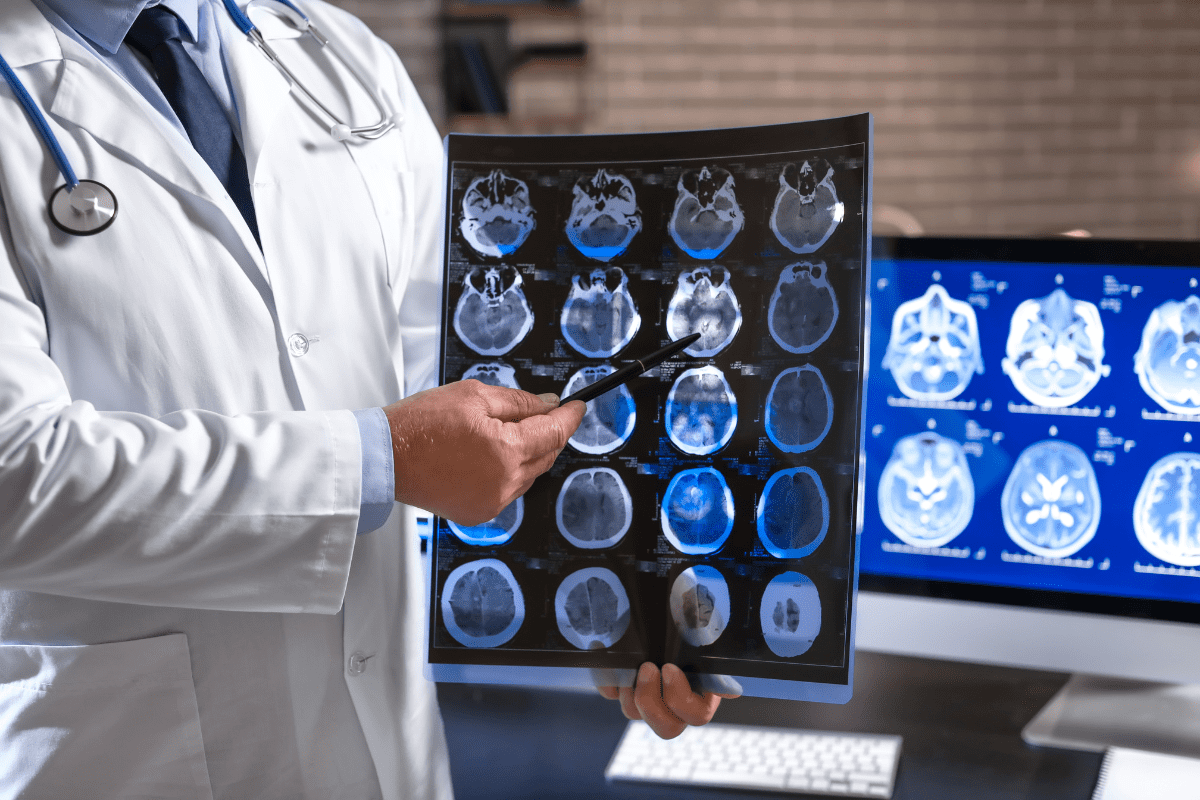
For an MS diagnosis, lesions must be present in the central nervous system (CNS) and they must appear in different parts of the CNS over time. The panel of experts that created the guidelines for MS diagnosis, believe that there is no value in examining the spinal fluid of MS patients for parasites. Yet it is well understood in science that parasites cause lesions in the brain and spinal cord. In this video, Pam Bartha discusses different parasites that cause lesions in the central nervous system.
Magnetic Resonance Imaging (MRI)
Magnetic Resonance Imaging or MRI is a technology that uses magnets to take detailed pictures inside the brain and spinal cord, which helps practitioners find lesions and other abnormalities in the CNS. It is used to detect and diagnose disease, and to also monitor the effectiveness of treatments.
How MS is Diagnosed
Standard of care asserts that in MS, the immune system attacks and damages the myelin of nerve cells, thus causing demyelination, which appears as lesions on MRI images.
For multiple sclerosis, MRI is a standard tool used to diagnose MS and help monitor a patient’s response to MS disease modifying drugs.
What are lesions?
In disease, lesions in the CNS are areas of tissue damage resulting from inflammation caused by white blood cells and fluid building up around blood vessels. The immune system’s primary job is to protect us from infection and in disease, the immune system is attacking something. The inflammation damages the myelin and axons of nerve cells. A lesion forms where tissue is damaged and overtime a build-up of scar tissue can occur in that area.
Lesions slow down or block the transmission of nerve impulses which causes many neurological symptoms, including the symptoms of MS. These symptoms can be temporary if the inflammation is resolved, or permanent if irreversible scar tissue sets in.
Lesions can appear and then disappear, and they can occur in any part of the central nervous system. Therefore, MS symptoms can vary greatly from one person to the next or even within the same person over the course of the disease.
Many diseases show lesions in the central nervous system
Many conditions or diseases are associated with lesions or plaques in the central nervous system. Migraines, radiologically isolated syndrome, spondylopathy, peripheral neuropathy, transverse myelitis, lupus, stiff person syndrome, Parkinson’s, Alzheimer’s, Lewy body dementia, multiple systemic atrophy, Huntington’s disease, multiple sclerosis, brain tumor, brain aneurysms, epilepsy, stroke, myasthenia gravis, fibromyalgia, small vessel disease, Bell’s palsy and infectious encephalomyelitis are just some conditions that are associated with lesions in the central nervous system. CNS Lesions may also be found in patients suffering from inflammatory bowel diseases like Crohn’s disease and colitis. People over the age of 50 often have lesions in the CNS. Therefore, lesions in the central nervous system are not only found in multiple sclerosis.
What do lesions look like?
Lesions usually may appear as white spots on MRI images (depending on the type of image) and can appear round, oblong, crescent shaped, linear or angular, or may have finger like projections. A person may have one or many lesions that vary in size from just a few millimeters to being large enough to touch one another.
Common MS lesions
The location of lesions in the CNS of MS can sometimes determine the kind and severity of the MS symptoms. In MS, characteristic lesions are found in the periventricular and juxtacortical regions, the brainstem, cerebellum, spinal cord, and optic nerve.[i]
Lesions can increase or decrease in size and/or number or remain stable over time. Myelin repair or remyelination may occur partially, or not at all.
New lesions may also be “clinically silent,” which means that they do not cause any physical signs. Thus, an MRI may show that a person has many lesions, but they may not have many symptoms.[ii]
Disease modifying maintenance pharmaceuticals are the only treatment options for MS at this time. If a significant amount of new inflammation shows on an MRI image while taking an MS drug, the prescribing doctor will consider switching to a different treatment.
Parasites cause lesions
Lesions may be due to damage directly caused by the parasite or indirectly by toxins they produce, or due to the immune response to the parasite.
One study looked at lesions caused by various parasites that can infect the back of the eye. They found that tapeworm larval cysts, roundworms, and various protists (Toxoplasmosis, malaria, Leishmaniasis and giardia can infect the back of the eye, which includes the optic nerve.[iii]
Parasites in the Central Nervous System
The central nervous system is not a sterile environment. Worms, protists, bacteria and fungi can and do infect the CNS and our immune system protects us from these parasites. If we suffer from a parasitic infestation and take drugs that suppress the immune system, the parasites can advance more quickly.
Scientific studies show that virtually any small parasite can invade the central nervous system and be associated with lesions, but tapeworm larval cysts are the most common.
Here are just a few studies that show the types of parasites that can be associated with lesions in the CNS:
1. “Toxoplasma (toxoplasmosis) encephalitis is often characterized by multiple ring enhancing lesions in the cortex and or basal ganglia.”[iv]
2. “One of the commonest causes of a single enhancing lesion in the brain is human neurocysticercosis, the infection by the larvae of the pork tapeworm, Taeniasolium.”[v]
3. “Lesions in the brain associated with malaria.”[vi]
4. Imaging in Lyme neuroborreliosis. “These and six other studies published between 1990 and 2007 included 10-27 subjects, and white matter lesions were found in 15-63% of the patients.”[vii]
5. Cerebral lesions are caused primarily by Schistosoma japonicum, and spinal cord lesions are due primarily to Schistosoma mansoniand Schistosoma haematobium.[viii]
6. “Here, we describe a case of spontaneous E. colimeningitis with multiple enhancing brain lesions and liver abscess in an immunocompetent adult that presented as generalized weakness.”[ix]
In conclusion, many parasites and many diseases are associated with lesions in the central nervous system and if this is the case, why are we not looking for parasites in the central nervous system?
All diseases are inflammatory conditions where the immune system is fighting something. The main job of our immune system is to protect us from infections or parasites. If autoimmune diseases were truly caused by the immune system attacking tissue in the body, and lesions are evidence of this, then why do the lesions come and go and increase and decrease in size? Why is it that some people have few lesions and many symptoms while others have many lesions and few symptoms? Are we to believe that our immune system randomly attacks our nerves and tissues sometimes, but not all of the time? If suppressing our immune system works so well, then why does disease continue to worsen while people take these drugs? Why is it that when people treat infections effectively, the so-called auto immune response stops?
Pathologist Dr. Alan MacDonald discovered small round worms and tapeworm larval cysts in the CNS system of every MS patient tested. He also found Borellia which is the bacteria that causes Lyme disease. There are approximately 100 years of studies linking MS to Lyme disease and a malaria Babesia type protist. If science has shown that these parasites are associated with lesions in the central nervous system, and science has also shown that these parasites can be found in the central nervous system of MS patients, then why are not looking for these parasites and treating them?
There are real solutions to recover from parasites today!
To restore health, we must focus on treating the cause of inflammation, which are parasites. First, identify the enemy (parasites), then support the body and treat the parasites while following a holistic approach. When parasitic infections are treated effectively, we can overcome inflammation or disease.
If you’re frustrated with the fact that our standard of care STILL doesn’t offer a real solution for treating MS and other diseases, then click on the link below to watch Pam Bartha’s free masterclass training and discover REAL solutions that have allowed Pam and many others to live free from MS and other diseases.
CLICK Here to watch Pam’s masterclass training
Or take the Health Blocker Quiz to see if you could have parasite infections
References:
[i] https://www.clevelandclinicmeded.com/medicalpubs/diseasemanagement/neurology/multiple_sclerosis/#:~:text=Of%20all%20the%20lesions%20in,fewest%20symptoms%20early%20in%20MS.
[ii] https://mssociety.ca/library/document/MjnK4fDhmUIi9OuLWVcZsJHeTYBzQ0kS/original.pdf
[iii] https://www.ncbi.nlm.nih.gov/pmc/articles/PMC4784073/#:~:text=Parasite%2Dinduced%20lesions%20may%20be,posterior%20segment%20of%20the%20eye.
[iv] https://www.sciencedirect.com/topics/medicine-and-dentistry/cerebral-toxoplasmosis#:~:text=Toxoplasma%20encephalitis%20is%20often%20characterized,found%20both%20supra%2D%20and%20infratentorially.
[v] https://www.ncbi.nlm.nih.gov/pmc/articles/PMC2931772/
[vi] https://jamanetwork.com/journals/archneurpsyc/article-abstract/650043
[vii] https://www.ncbi.nlm.nih.gov/pmc/articles/PMC6206375/#:~:text=in%201988%20and%201989%2C%20focused,patients%20%5B23%E2%80%9328%5D.
[viii] https://pubmed.ncbi.nlm.nih.gov/8011815/#:~:text=The%20CNS%20is%20an%20unusual,Schistosoma%20mansoni%20and%20Schistosoma%20haematobium.
[ix] https://www.cureus.com/articles/89376-spontaneous-escherichia-coli-meningitis-and-brain-abscess-in-an-immunocompetent-adult#!/

Clinically diagnosed with multiple sclerosis at the age of 28, Pam chose an alternative approach to recovery. Now decades later and still symptom free, she coaches others on how to treat the root cause of chronic disease, using a holistic approach. She can teach you how, too.
Pam is the author of Become a Wellness Champion and founder of Live Disease Free. She is a wellness expert, coach and speaker.
The Live Disease Free Academy has helped hundreds of Wellness Champions in over 15 countries take charge of their health and experience profound improvements in their life.

